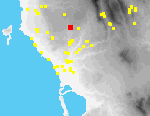 I19 Pyrgaki Tsouka
I19 Pyrgaki Tsouka
Tsouka is a small knoll (340 masl.), near the end of a long ridge running SW from the village of Pyrgaki, ca. 1 km. S of the outskirts of that village[036.14]. Bulldozing has shaped the knoll into a cylinder of bedrock with near vertical sides[092.33]; scrub brush and grasses grow in a shallow deposit of soil on top of the knoll around a trigonometric point. Beyond the knoll, the ridge slopes gently to the NE, more abruptly to the NW and S; a dirt road runs S of the site. The feature was noted by the UMME team (PHSP1: 237 [39]) who describe it as a (possible MH burial) mound ca. 12 m. (E-W) x 9 m. (N-S) x 5 m. H. By the time our teams visited the location, a central cylinder (ca. 14 m. D.) had been created by bulldozing the edges of the mound[019.21]. High in the NE and NW scarp of the cylinder were numerous human bones, large fragments of tile, and small amounts of pottery. Other artifacts were found at the foot of the cylinder, especially on its NW and SW sides. None of these artifacts can be assigned to the PR period and the possible dates for the burials include HL-R or Byz-Turk. During the 1993 season the feature was further bulldozed, leaving only the center of the cylinder intact (ca. 5.4 m. D. x 3.5 m. H.), in which bones and tile are still visible in the NW and NE scarp[092.34].
Collected material is 95% tile and pithos fragments. Tile fragments can be divided into Hellenistic/Roman and Byzantine/Turkish. The pithos fragments, body sherds, are not diagnostic. Sherds are abraded and should be dated, on the basis of fabric, to the post-Byzantine period.